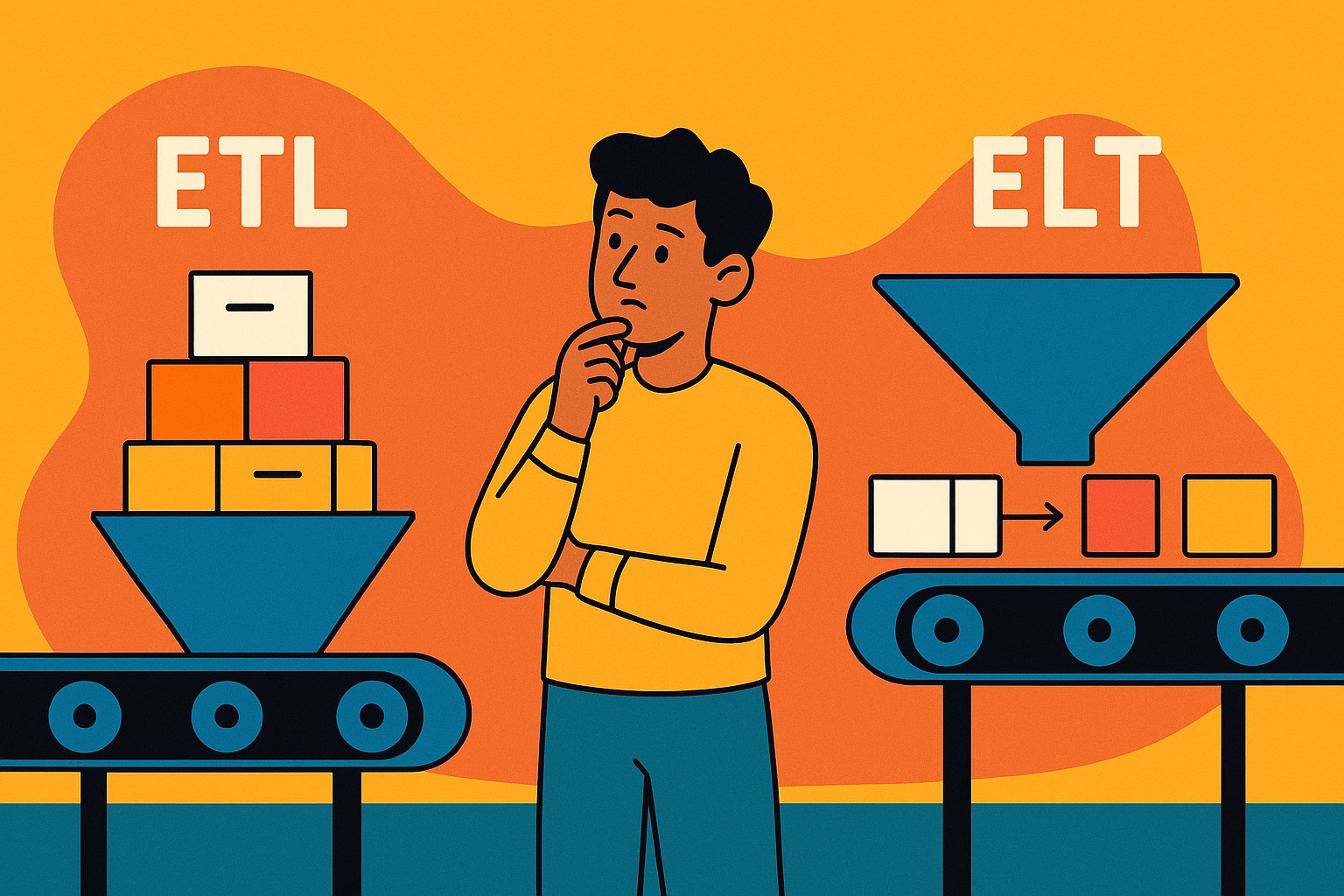iPaaS as a Catalyst in ELT Processes
As organizations grapple with increasingly complex data landscapes, the need for seamless, efficient, and scalable Extract, Load, Transform (ELT) processes has become more pressing than ever. While ELT has long been an instrumental cog in the data management machinery, it's frequently hindered by issues such as scalability constraints, the need for manual oversight, and complex integration points that require bespoke solutions. The pivot toward more agile and integrated processes thus begs the question: Can Integration Platform as a Service (iPaaS) be the transformative element that redefines ELT for the modern era? To probe this question and unveil the synergies between iPaaS and ELT, we embark on this comprehensive exploration.
The growing capabilities of modern data platforms have opened new vistas of possibility. Yet, these often come with challenges that threaten to undermine the efficiencies gained. It's like standing at a junction where multiple paths converge, and a guide is needed to navigate through this complexity. iPaaS emerges here as that guide, offering not just a direction but also a methodology. This paper aims to dissect the role of iPaaS in ELT processes, exploring how it can serve as a conduit for seamless integration, automation, and orchestration across a multitude of data sources and platforms.
A Brief History of ELT
To understand the current landscape, one must look at the evolution of ELT processes. In the early days of data storage and management, ELT processes were primarily confined to on-premises databases. But the advent of cloud computing has shifted these processes towards cloud-native environments. Alongside this shift has been a burgeoning complexity in data architectures, which has significantly upped the stakes for streamlined and efficient ELT processes.
iPaaS Unveiled
The concept of Integration Platform as a Service (iPaaS) brings a multi-faceted approach to dealing with the intricacies of modern data architecture. While its primary role is facilitating integration between disparate systems, it's imperative to understand that iPaaS is not just an "add-on" or "bolt-on" component. It's a dynamic, cloud-based platform designed for adaptability, scalability, and agility.
iPaaS takes an umbrella approach to system integration. It encompasses everything from data sourcing to data mapping, transformations, and even governance. This turns it into an enabler, creating the architectural underpinning for efficient and effective ELT processes.
But where iPaaS truly shines is in its ability to create a bridge between the legacy and the modern, the on-premises and the cloud-based, and the structured and the unstructured. It's not merely about making these systems compatible; it's about making them communicate in a language they both understand. That's a vital distinction. iPaaS changes the conversation from "Can these systems talk to each other?" to "How can these systems provide the most value when they interact?"
The Architecture of iPaaS
To appreciate the transformative power of iPaaS fully, it's essential to dissect its architectural components. Fundamentally, an iPaaS platform comprises several integral elements that collectively offer a holistic integration solution. These are not mere cogs in the wheel; they are the wheel.
Connectors
The architecture begins with connectors, which act as interfaces between different data sources and the iPaaS platform. Whether you're dealing with SQL databases, NoSQL repositories, APIs, or even legacy systems like mainframes, connectors ensure that the data can be ingested into the iPaaS platform effectively. It's like having multiple adapters for different types of plugs, allowing them all to connect to a single power source.
Orchestrators
Next, we have orchestrators, which are the conductors of this complex symphony of data movement and transformation. Orchestrators manage the data flow, sequencing tasks in the ELT process based on dependencies, priorities, or even specific conditions. This role of the orchestrator turns iPaaS into a process-efficient and error-minimizing platform, giving enterprises the agility they need to adapt to evolving data requirements.
Data Pipelines
Lastly, the architecture incorporates data pipelines. A pipeline is essentially a set of data processing elements connected in series, where the output of one element is the input to the next. Pipelines in iPaaS can be linear or complex, involving multiple branches, decision points, and even loops. They carry the data from one stage to another within the ELT process, doing so in a manner that is both transparent and controllable.
Collectively, these architectural components allow iPaaS to fit seamlessly into any existing data architecture, irrespective of its complexity or variety. They offer the robustness needed to handle high-volume, high-velocity data while ensuring that data integrity, quality, and governance are never compromised.
The Integration Layer: Making ELT Seamless
One of the cornerstone features of iPaaS is seamless integration. Traditionally, ELT processes might require custom coding or manual configurations to ensure that data from diverse sources could be integrated. With iPaaS, this integration becomes less of a challenge and more of an automated process. The platform offers connectors that can interact with APIs, databases, and even legacy systems, allowing for smooth data movement and protocol transformations—be it REST, GraphQL, or SOAP.
The Automation Effect: Efficiency in ELT
Automation is another domain where iPaaS demonstrates immense value. In traditional setups, ELT processes often suffer from manual inefficiencies. A Forrester report states that organizations can reduce manual effort in ELT processes by up to 60% through automation. iPaaS achieves this by enabling the creation of data pipelines that can automatically carry out a series of operations—right from extracting data from multiple sources to applying complex transformations and finally loading it into a target database.
Orchestration: The Maestro of Data Workflows
Perhaps one of the most understated aspects of iPaaS is its orchestration capabilities. Managing a series of dependent or interrelated tasks can be a monumental undertaking. iPaaS serves as the maestro in this symphony, ensuring each instrument—be it event-driven, time-based, or condition-based—plays its part at the right time, creating a harmonious data workflow.
Enhancing Data Quality & Governance
High-quality data is the lifeblood of any analytical process. iPaaS contributes to this by allowing for data quality checks and validations as data moves from one stage to another in the ELT pipeline. Beyond this, iPaaS plays a vital role in data governance by offering features like role-based access control and audit trails, thereby establishing a robust framework for secure data management.
Security & Compliance
Speaking of secure data management, iPaaS goes to great lengths to ensure that data is securely transferred and stored. Martin Fowler once said, "You can have the fastest and most efficient system in the world, but if it's not secure, you don't have anything." iPaaS incorporates multiple security layers, such as encryption, data masking, and secure data transfer protocols, ensuring not just efficiency but also robust security. On the compliance front, iPaaS solutions are increasingly being designed to manage regulatory issues such as GDPR and CCPA, adding an extra layer of security assurance.
The AI and Machine Learning Connection
While iPaaS already has a wide array of capabilities, the integration of Artificial Intelligence (AI) and Machine Learning (ML) is taking it a step further. Andrew Ng famously stated, "AI is the new electricity," and its significance is increasingly evident in ELT processes. With machine learning models, iPaaS can offer advanced data mapping, error detection, and even predictive analytics, thereby adding another dimension to how ELT processes are executed.
The Caveats: What to Look Out For
Of course, iPaaS is not without its limitations. Vendor lock-in remains a concern for organizations that adopt platform-specific solutions. Additionally, while iPaaS can dramatically reduce the complexity of ELT processes, the complexity of adopting and managing the iPaaS solution itself can be significant. There are also cost considerations for advanced functionalities and scalability requirements.
Evaluating iPaaS Solutions
Given these factors, it becomes critical for organizations to have a comprehensive evaluation strategy when considering iPaaS solutions for ELT. Questions around scalability, ease-of-use, supported integrations, and the underlying technology stack should form the basis of this evaluation.
Future Outlook
As we look towards the future, iPaaS stands to gain from innovations in machine learning, real-time analytics, and blockchain technologies. These advancements are likely to further embed iPaaS as an invaluable asset in the constantly evolving landscape of ELT processes.
iPaaS the Quintessential Linchpin for Modern ELT
If the discourse up to this point has made anything abundantly clear, it is that iPaaS presents a multifaceted solution for the challenges that ail traditional ELT processes. But more than just a fix, iPaaS heralds a transformative shift in how organizations can approach ELT processes—it redefines the underlying architecture, injects efficiency through automation, and ushers in an era of data orchestration that is meticulously designed and impeccably timed.
For organizations that aim to extract the utmost value from their data, the role of iPaaS in ELT processes transcends the optional. It becomes a fundamental requisite—a linchpin that holds together the various elements of data management, from sourcing to transformation and delivery. The implications here are not just operational but strategic, stretching across facets from time-to-market to decision-making agility.
As we look to the horizon, it is evident that iPaaS will continue to evolve, incorporating next-gen technologies and capabilities. This progression will only deepen its role in ELT processes. Therefore, as organizations gauge the future trajectory of their data strategies, iPaaS stands not merely as an asset to consider but as an imperative to act upon. Whether your organization is already deep into its data journey or just setting sail, the presence or absence of a robust iPaaS solution could well be the fulcrum upon which the success of your ELT processes—and by extension, your data strategy—pivots.
 is now
is now


